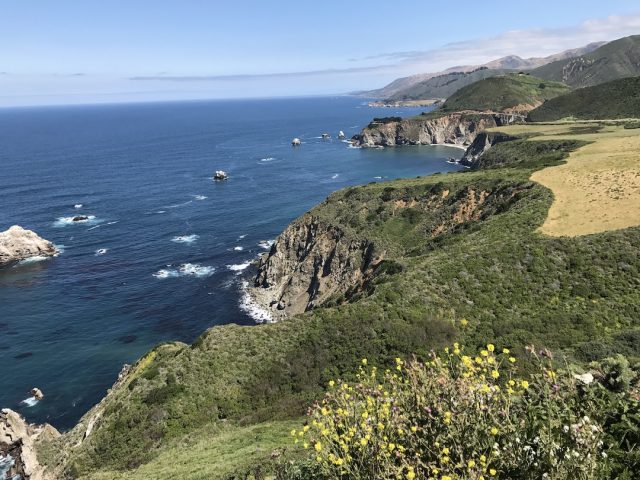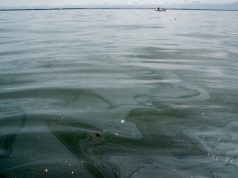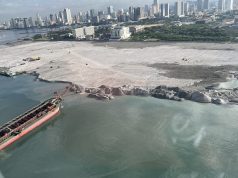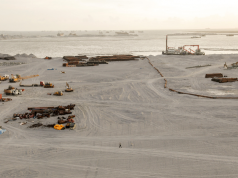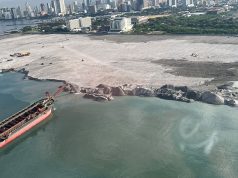On clear days, one of the dangers to motorists heading for Monterey Bay is being distracted by the sea. All it takes is a sideward glance to see how the waves change color as they approach the coast. First a deep blue, then aquamarine, then a shift to cyan near the rocks jutting from the water’s surface. Without noticing it you would then careen straight over one of the many bends in the road, falling past sheer cliffs to join the waves as they crash on the stony shore.
It seems funny and a little strange that the first thing my family did after landing at San Francisco was leave it. Ninang Jeng picked us up the moment we stepped out of the airport. We would be staying at her house for two weeks, in a town called Hercules 30 minutes away from San Francisco by drive.
Over the next few days, we would visit Berkeley, then Monterey, then the areas around Monterey, as if shyly orbiting the big city in an effort to get both as close and as far away from it as possible.
But the city’s pull could not be ignored. Even the clouds were drawn to it, escaping the inland heat and channeled by winding valleys towards the cold waters of the Pacific. Masses of them gathered on hilltops near the coast, fat, blanket-thick, and freakishly low; they would skim the tops of buildings, or shroud the Golden Gate Bridge, floating low enough to touch with the tip of a finger. And sometimes they went even lower, turning from cloud to fog as they slid down mountains to envelop the city in whiteness.
Maybe it’s why, barring downtown, San Francisco’s engineers restricted themselves to building structures no more than three-stories tall. It’s a city that loves space. This is one of the few places where you can find yourself in the middle of a major street and still have a clear view of the sky. For someone who grew up in a place littered with skyscrapers and skyways, the effect could be disconcerting, the feeling of an unobstructed horizon similar to being caught out in the open.
This isn’t even going into the numerous parks dotting each district where anyone can lie down on the grass and relax, free to do anything—from sipping wine to smoking marijuana. The largest, Golden Gate Park, stretching for tens of blocks on the city’s west side seems more forest than anything else. Stroll inside it long enough and you could forget the rows of apartments ringing the park on three of its four sides.
Not to say the city is flat. It has eleven hills that roll up and down like roller coasters, and with varying elevations that could exhaust pedestrians unused to rapid changes in elevation. Residents are the only ones who seem to be unbothered by frequent 45-degree inclines.
Once, we spotted an old Asian lady exercising by walking backwards up a steep hill, looking so relaxed the only thing missing was for her to start whistling.
People walk San Francisco for the suave of its streets. Downtown Union Square is all glass and steel and loaded with major brands. For pretty Victorian townhouses you can go down Hyde Street next to Dolores Park, and from there it’s a short walk to the frenetic murals of Clarion Alley. Sidewalks are always broad and accessible. Most of the time you encounter people walking their dogs. Joggers cut through neighborhoods of every kind, something that reflected the surrounding diversity in race and culture.
Residents come from across the entire world. From Africa, South Asia, Central America, East Asia, the Middle East, and more. For people called part of a minority, there were at times more of them than the white people said to be the majority. The cutest girl I saw during the whole trip was an Arab waitress serving falafel in Ali Baba’s Cave along Valencia Street. I swear all the men and some of the women eating there with me couldn’t help looking at her, too.
In San Francisco you will also find the gayest place on Earth, Castro Street, with rainbow flags flapping gloriously from every third lamppost, where each May is Harvey Milk month, and where you can find pictures of naked bodybuilders posted on the largest windows. This city has everything indeed, including penis-shaped cookies for only $3.99.
But something changes past the city limits. The farther towns get from the city, the more and more they slowly turn white. A white of the rich kind, the type you can’t help but think plays golf. In Napa Valley, white men in polo shirts and loafers almost became a stereotype, along with older white men in leg sweaters and visor caps. There wasn’t one black man strolling between the multi-million villas of Carmel-by-the-sea. It was as if someone had painted the entire Northern Californian countryside with bleach.
In time it became noticeable how subtle segregation affected San Francisco too. Valencia Street was one of the neatest avenues in the city. The sidewalk was clean and well-kept. Aside from Ali Baba’s Cave it had a lot of designer cafes and artisanal shops. People of all colors walked around, but more white than anything else.
Meanwhile, punching just a block east was Mission Street, where graffiti streaked the pavement and collapsible gates protected apartment doors. One segment of the road was dominated by thrift stores, the other by pawn shops. Black dudes in loose jeans rapped by the subway entrance. Latinos chatted casually next to smoke shops. It had a muscular feeling, this was obviously a tough community, the kind you didn’t want to drop a dime or dollar in because it had that kind of grit. And like other similarly worn places, the number of white people walking down it could be counted on one hand.
The city had something sour at its foundations. There was something dishonest about a diversity where people, consciously or not, still erected homes and workspaces along racial divides. It’s not a happy home if everybody sleeps and eats in different rooms. What would be the point of living together at all?

And why were there so many mentally ill people wandering around the streets? Half the homeless didn’t beg for change here. Instead they raved or ranted or spouted gibberish towards the nearest spotlight while carrying soiled blankets on their backs. The most disquieting were the ones who always stared straight ahead. Their eyes would be dead and glassy, sometimes their mouths would be half-open, and they’d walk around like zombies, minds stuck somewhere they couldn’t get out of.
What was similarly sinister, at least to someone from Metro Manila, was how the suburbs looked so barren. Even in Hercules, where we stayed. You could walk down an entire street and see home upon home but no living soul outside at all. It felt utterly alien. It could have come straight out an episode of CSI. Who knew what went inside these identical looking houses, every one of them with a big garage and staring at you with curtained windows for eyes? No one would ever trust an ice cream truck down here. Not even a child.
Size and mobility are two things sacred to America. It’s why they love their cars and their shopping carts, both important for warehouse-sized Target stores where everything comes in packs of 24 or more. Nowhere is this more evident than in the country’s highways, broad belts of concrete crisscrossing the US like veins. At night they resemble rivers of streaming red and yellow light, cars flowing in smoothly from adjoining roads to join the rushing, coursing traffic of trucks and sedans.
Being poor here often meant one thing—not having a car. Something that could mean being stuck in poverty, without the means to move upwards or sidewards or anywhere entirely. There were buses and trains, yes, but you had to get to the station first, which could be miles away. The Bay Area was a heartbreaking place to be carless in. There were simply too many things you could do here, too many sights you had to go and see.
Road culture is American culture. And why not? Much of the countryside still retained some faded allure of the Wild West, a hint of the echoing vastness which drove America’s first European colonists to strike out and violate its native inhabitants. It had something to do with looking out a car window and seeing nothing but prairie grass and deepening sunset sky.

Just those two strips of color until the night, an endless, panoramic painting rendered carelessly with gold and Venusian purple. Like the world had been turned flat as a canvas. Like the painter’s hand was still going somewhere far over the horizon, just out of reach.
There’s a reason the Bay Area has one of the greatest concentrations of outdoor freaks in the world. It has everything an aspiring outdoorsman could ever want. For a weekend, you could choose between camping, biking, fishing, hiking in Mt. Tamalpais, or kayaking down the Merced River. And in winter, skiing by Lake Tahoe.

You could climb cliffs in Yosemite, go bird watching in the marshes, or alternatively go bird hunting in the marshes if it was the right season. These people were hardcore. They knew the nature around them was beautiful, and they knew how lucky they were to have it.
Recreation here is ridiculously easy. If you’re feeling lazy about going anywhere past the Golden Gate Bridge, that’s cool. There are more than enough things to do in the city, too. Like shopping for books, because I encountered so many bookstores while wandering around it started to feel like a curse. For music aficionados, the same could be said for record stores, and for art-heads, museums. There are so many paintings and sculptures I actually passed Rodin’s The Thinker without noticing it. The place has everything, except fashion. The only thing people wear here is North Face.

Paris went west once, didn’t you know? From being a backwater outpost San Francisco had gained the nickname ‘Paris of the West’ by the 1880’s, mostly because of an earlier bum-rush for gold. It had hosted Twain and Kerouac. Its careless beauty had once attracted Diebenkorn and Larry Sultan. And when the 60’s came by with truncheons and flowers and Governor Reagan, it was the Grateful Dead that came shambling out of Haight-Ashbury to meet it.
For those who could afford it, San Francisco and the surrounding Bay Area offer a life that is more than just a daily existence. It’s a place where you are free to love, to pray, to make music or to make art, to read, write, or play ball, to ride a bike or eat ice cream, or all at the same time.
The meaning of a city is to have people live together. Which isn’t the same as plopping down rows of apartments next to a high-rise mall, because then the only thing you’d be giving them was a house and a job and a place to spend their money in. Cities need spaces where people can think and talk, to eat and go running with their dogs. Cities need parks. Cities need museums. Cities need schools and libraries. More than that, cities need ways for people to get both out of the city as well as further into it, to move to and from the surrounding spaces that make it thrive. Because a city doesn’t exist in a vacuum. It runs and is dependent on both internal and external connections that link the busiest downtown streets with the farthest residential areas.
Good urban infrastructure encourages creativity through the sharing of ideas. A reliable public transport system quickly carries not just commuters and the goods they bring with them, but the personal experiences which created those goods in the first place. Continuous flow prevents stagnancy. Without working trains, buses, and traffic control, a city degrades into a collection of isolated human pockets, each unable to connect and perform with the kind of coordination needed for the city and its inhabitants to learn and grow as a cohesive whole.
On the way to the United States, the San Francisco I had in my mind was sort of a paradise. It was partly TripAdvisor’s fault and my own bloated expectations of the city as a beacon of progressivity. It didn’t help how San Francisco always ranked near the top of “livable city” lists. Something it of course deserves, b given its protection of natural areas and free-thinking atmosphere. If we were to judge cities based on the number of museums they contain, then San Francisco would be at the top of any list.
Such a list would, of course, ignore the extant inequality and the segregation, and the fact that half the city’s homeless should be in mental wards. It would also gloss over the subpar public transport system, something you noticed more on the highway during rush hour when Routes 580 and 101 are choked with cars, most with only one or two passengers inside.
For all its fame, San Francisco, the city of fog, is also a city with problems. A state of reality that was honestly somewhat relieving. The bad does not sweep away the good. San Francisco is still one of the most open and diverse places in the world, a center of culture and science with unmatched natural beauty. Perfect societies exist only in dystopias, and even then only at the surface.
I am not a religious person. I hardly ever go to church. But the closest I have ever felt to God was when I wandered the Muir Woods, staring upwards at titanic redwood trees. The only piece of human architecture comparable to a grove of these giants is St. Peter’s Cathedral in Rome, or Angkor Wat in Cambodia. Both are massive temples meant to convey a sense of awe and mortal puniness. The same applies here, except the sheer size is felt through trunks that look like the fossilized pillars of Earth’s rusted blood. When I was a child my preferred afterlife was to reincarnate as part of a forest. And if I do, I would want to wake up here, in the Muir Woods, reaching for the heavens as a dreaming redwood tree.

A spiritual experience generally derives from a feeling of something larger than you. This feeling is what often inspires faith and religion. Curiously, something similar drives much of science, albeit with different results, in the sense that scientists perceive the existence of the vastly unknowable as a challenge rather than a curse. Faced with an orchid a priest would likely declare the intricate flower a work of God. An evolutionary biologist, on the other hand, would instead interpret the orchid’s complex petals as improvised derivatives of past ancestral forms, seeing the entire plant as part of an ongoing process going back billions of years. To a scientist, the universe is something more to be understood rather than worshipped.
Thankfully, the desire to understand is often paired with a desire to share understanding. Hence the California Academy of Sciences, or CalAcademy, one of the largest natural history museums in the world, a breezily designed building situated right in the middle of Golden Gate Park. In an interesting duality, across the street stood de Young Museum of Art, constructed using darkly rusting metal not out of place in a scrapyard. Taken together, the pair looked like a yin-yang representation of the human psyche, one dark and imposing, the other light and welcoming.
The biggest part of CalAcademy’s appeal is its collection of miniature ecosystems kept behind clear walls of glass. Populating them were frogs from Uruguay, giant geckos from Madagascar, and cichlids from the freshwaters of Borneo, living in spaces approximated to their home environments as closely as possible. Most spectacular is the globe-shaped rainforest biome that stands over three stories tall. You have to appreciate the kind of determined insanity needed to maintain an actual piece of tropical jungle, complete with pressure doors to protect against contamination, completely different internal humidity, and UV lamp arrays simulating equatorial heat and sunlight.
It can make a person wonder what kind of world it would take where all these plants, all these animals, only remained here, as curations in a museum. At least part of the Philippine’s reefs would survive. CalAcademy has an aquarium large as a room just for them, and with the requisite fish and anemone is one of their biggest and most popular exhibits. Seeing it all behind a glass pane somehow felt more striking than any snorkeling trip. For one thing the grandeur was immediate, with no slow transition from beach to coast to reef.
It felt painfully ironic to consider our reefs would be so well preserved here, thousands of miles away from home, while in 50 years their wild cousins could all be dead from a warming sea. What would the Philippines be like without reefs? Biodiversity is part of our national identity. It’s something we’ve always been proud of, but not taken care of.
Symbols are integral to forming an identity. They provide something people can rally around whenever the need arises. It’s why people from the Bay Area love otters, and the Golden Gate Bridge. Thinking along similar lines led me to form a theory that, hear me out, their support for Golden State sports teams has in some way become a regional religion. Think about it. Both sports and religion involve being part of a community that worship something vastly greater than they were. In religion’s case, that being is usually a god, or set of gods, while in sports it’s the Golden State Warriors.
Both are also similar in that they promote the formation of groups. They play an important part in forming an identity. What faith do you belong to? Roman Catholic. What team do you support? Warriors.
Game 3 of this year’s NBA finals came on the same day my family was going to fly home. Before we went to the airport my father insisted we first watch the game in a bar called BJ’s Brewery. In that bar everyone was wearing yellow, specifically Warriors yellow. Yellow shirts, blazers, caps, anything that could conceivably be part of a Golden State uniform. Everyone was their own commentator. If you wanted the fastest play-by-play analysis of the game, the only thing you had to do was stand next to the bar and listen to the crazy fan in sweatpants heckle LeBron while at the same time plead with Durant as if the Warriors forward had suddenly become an angel of God.
By the time we left to catch our plane in the 4th quarter, the bar was in a downcast mood. The single digit gap, which had hovered between both teams for most of the game, had now increased to a five-point lead for the Cavaliers. At the airport, I was surprisingly blue, too. From being utterly clueless about basketball I had become a Warriors fan, just from being in a raucous bar where everyone else was a Warriors fan, too.
While waiting in line for security, I heard a cheer slowly roar up from deep inside the airport. People began smiling. The queue took a tiny break as airport staff began high-fiving and clapping each other on the back. Dad went up to security and asked, “Did we win?” The guard smiled. “We won.”

Before I left for the United States, I made a visit to Manila Bay. I wanted to know how the water there would compare to the waters of San Francisco. And what they were was brown-green and sludgy, smelling like fertilizer and melting Styrofoam, with shoals of plastic floating on the murky surface. Nearby people slept on fish-net hammocks between dying palm trees. Still, you could see couples bringing their children to see the sea, and teenagers riding bikes beside the breakwall. But the only ones reckless enough to dare swim in the bay were small children who laughed while filthy water streamed down their bare backs.
Now, below me, as the plane circled Manila, I could see the bay again, this time black from the night, a clean black like a plain of obsidian. The aircraft rocked gently as it started to descend. Pinpricks of orange light emerged, embers on a dark blanket, coming from the lamps, houses, and bustling cars of the gigantic metropolis. Without the sun you couldn’t see the trash on the pavement, or the grime lining the streets. My city always looks best at night.
When the plane finally stopped on the tarmac passengers started clapping. “We’re the only ones who do that,” said my father.
“Do what?” I asked.
“Clap when we get back home.”

